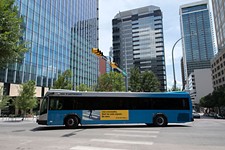Improving Safety and Access on the Lakeside Hike and Bike
Caring for the trail
By Benton Graham, Fri., March 26, 2021
With around 4.5 million yearly visits, the Ann and Roy Butler Hike-and-Bike Trail offers many Austinites a relaxing escape from city life in the heart of Downtown. But as Austin continues its extraordinary growth, how can the lakeside trail continue to be an oasis in the urban landscape?
That's one of the questions the Trail Foundation tried to answer in its recently released Safety and Mobility Study. The foundation partnered with the city of Austin's Parks and Recreation Department and Public Works Department's Urban Trails Program for the project, which took over a year to identify ways to improve safety and connect the Butler Trail to the city's greater network of trails. Its recommendations include lighting adjustments, linking the trail to the city's All Ages and Abilities Bicycle Network of protected bike facilities, and using different surface materials to combat erosion.
The foundation encountered immediate challenges as it launched its efforts to engage with trail users in person at the beginning of March. "Suddenly the world became engulfed in the pandemic, and we had to go virtual," said Charlotte Tonsor, project director at the foundation. The foundation leaned heavily on digital outreach via its website and social media, as well as phone calls. One tool was its Wikimap survey, allowing respondents to input locations on a map and upload photos of conditions they'd seen on the trail. The foundation also surveyed trail users to evaluate six trail issues: trail width, surface conditions, connecting the network, lighting, accessing the trail, and directional signage. Surface conditions emerged as the highest priority, with 93% of respondents identifying them as important.
The pandemic also offered a unique opportunity for observation. As Austinites looked for COVID-19-safe activities, they flocked to outdoor venues like the Butler Trail. "People were definitely packing the trails, and it was a good little glimpse and snapshot of what this could be," Tonsor said. The trail tested switching from a two-way to a one-way route at the beginning of the pandemic; it has since gone back to a two-way traffic flow.
The study also discussed efforts to pursue a strategy of "equitable engagement" by conducting outreach to "people of color, people with disabilities, and people with low incomes." The surveys included versions in both English and Spanish. However, the Wikimap survey indicated that 84% of respondents were white, and 61% had a household income above $100,000. According to census data, 73% of Austin identifies as white, and the median household income is $71,576.
D'Anne Williams, a project manager for the city and a partner on the study project, said that equity has been a focus of both the Trail Foundation and the city. "We have some existing relationships with groups on the Eastside," she added. "They made a point of actually calling them on the phone and making contact with those groups that do not always log in to the [online] response surveys." The Trail Foundation reached out to neighborhood associations, social fitness groups, apartment condo communities, and advocacy groups, Tonsor said. The study lists the city of Austin Equity Office and the offices of Mayor Pro Tem Natasha Harper-Madison and Council Member Kathie Tovo as participants in its stakeholder interview process.
Of course, these projects also cost money. But Williams said it's unlikely that the funding for these projects would take money away from another project elsewhere in the city. "The Trail Foundation is very good at grants opportunities," she said. Future bonds, partnerships with other city departments, and donations from businesses all present opportunities to secure the necessary funding, Williams added.
The Trail Foundation is hoping that the study results will help the city balance the trail as a natural respite with its massive growth, Tonsor said. "It's really about, how do we maintain that place everyone loves, all those environmental features and natural features, and then come up with all these alternatives that we can do, rather than just saying, 'We're going to make the trail much wider.'"
Got something to say on the subject? Send a letter to the editor.









